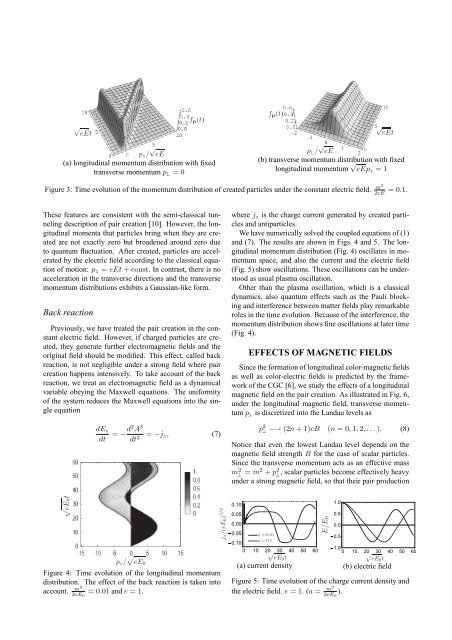Proceedings of International Conference on Physics in ... - KEK
Proceedings of International Conference on Physics in ... - KEK
Proceedings of International Conference on Physics in ... - KEK
Create successful ePaper yourself
Turn your PDF publications into a flip-book with our unique Google optimized e-Paper software.
(a) l<strong>on</strong>gitud<strong>in</strong>al momentum distributi<strong>on</strong> with fixed<br />
transverse momentum p⊥ = 0<br />
(b) transverse momentum distributi<strong>on</strong> with fixed<br />
l<strong>on</strong>gitud<strong>in</strong>al momentum √ eEpz = 1<br />
Figure 3: Time evoluti<strong>on</strong> <str<strong>on</strong>g>of</str<strong>on</strong>g> the momentum distributi<strong>on</strong> <str<strong>on</strong>g>of</str<strong>on</strong>g> created particles under the c<strong>on</strong>stant electric field. m2<br />
2eE = 0.1.<br />
These features are c<strong>on</strong>sistent with the semi-classical tunnel<strong>in</strong>g<br />
descripti<strong>on</strong> <str<strong>on</strong>g>of</str<strong>on</strong>g> pair creati<strong>on</strong> [10]. However, the l<strong>on</strong>gitud<strong>in</strong>al<br />
momenta that particles br<strong>in</strong>g when they are created<br />
are not exactly zero but broadened around zero due<br />
to quantum fluctuati<strong>on</strong>. After created, particles are accelerated<br />
by the electric field accord<strong>in</strong>g to the classical equati<strong>on</strong><br />
<str<strong>on</strong>g>of</str<strong>on</strong>g> moti<strong>on</strong>: pz = eEt + c<strong>on</strong>st. In c<strong>on</strong>trast, there is no<br />
accelerati<strong>on</strong> <strong>in</strong> the transverse directi<strong>on</strong>s and the transverse<br />
momentum distributi<strong>on</strong>s exhibits a Gaussian-like form.<br />
Back reacti<strong>on</strong><br />
Previously, we have treated the pair creati<strong>on</strong> <strong>in</strong> the c<strong>on</strong>stant<br />
electric field. However, if charged particles are created,<br />
they generate further electromagnetic fields and the<br />
orig<strong>in</strong>al field should be modified. This effect, called back<br />
reacti<strong>on</strong>, is not negligible under a str<strong>on</strong>g field where pair<br />
creati<strong>on</strong> happens <strong>in</strong>tensively. To take account <str<strong>on</strong>g>of</str<strong>on</strong>g> the back<br />
reacti<strong>on</strong>, we treat an electromagnetic field as a dynamical<br />
variable obey<strong>in</strong>g the Maxwell equati<strong>on</strong>s. The uniformity<br />
<str<strong>on</strong>g>of</str<strong>on</strong>g> the system reduces the Maxwell equati<strong>on</strong>s <strong>in</strong>to the s<strong>in</strong>gle<br />
equati<strong>on</strong><br />
dEz<br />
dt = −d2 A 3<br />
dt 2 = −jz, (7)<br />
Figure 4: Time evoluti<strong>on</strong> <str<strong>on</strong>g>of</str<strong>on</strong>g> the l<strong>on</strong>gitud<strong>in</strong>al momentum<br />
distributi<strong>on</strong>. The effect <str<strong>on</strong>g>of</str<strong>on</strong>g> the back reacti<strong>on</strong> is taken <strong>in</strong>to<br />
account. m2 = 0.01 and e = 1.<br />
2eE0<br />
where jz is the charge current generated by created particles<br />
and antiparticles.<br />
We have numerically solved the coupled equati<strong>on</strong>s <str<strong>on</strong>g>of</str<strong>on</strong>g> (1)<br />
and (7). The results are shown <strong>in</strong> Figs. 4 and 5. The l<strong>on</strong>gitud<strong>in</strong>al<br />
momentum distributi<strong>on</strong> (Fig. 4) oscillates <strong>in</strong> momentum<br />
space, and also the current and the electric field<br />
(Fig. 5) show oscillati<strong>on</strong>s. These oscillati<strong>on</strong>s can be understood<br />
as usual plasma oscillati<strong>on</strong>.<br />
Other than the plasma oscillati<strong>on</strong>, which is a classical<br />
dynamics, also quantum effects such as the Pauli block<strong>in</strong>g<br />
and <strong>in</strong>terference between matter fields play remarkable<br />
roles <strong>in</strong> the time evoluti<strong>on</strong>. Because <str<strong>on</strong>g>of</str<strong>on</strong>g> the <strong>in</strong>terference, the<br />
momentum distributi<strong>on</strong> shows f<strong>in</strong>e oscillati<strong>on</strong>s at later time<br />
(Fig. 4).<br />
EFFECTS OF MAGNETIC FIELDS<br />
S<strong>in</strong>ce the formati<strong>on</strong> <str<strong>on</strong>g>of</str<strong>on</strong>g> l<strong>on</strong>gitud<strong>in</strong>al color-magnetic fields<br />
as well as color-electric fields is predicted by the framework<br />
<str<strong>on</strong>g>of</str<strong>on</strong>g> the CGC [6], we study the effects <str<strong>on</strong>g>of</str<strong>on</strong>g> a l<strong>on</strong>gitud<strong>in</strong>al<br />
magnetic field <strong>on</strong> the pair creati<strong>on</strong>. As illustrated <strong>in</strong> Fig. 6,<br />
under the l<strong>on</strong>gitud<strong>in</strong>al magnetic field, transverse momentum<br />
p⊥ is discretized <strong>in</strong>to the Landau levels as<br />
p 2 ⊥ −→ (2n + 1)eB (n = 0, 1, 2, . . . ). (8)<br />
Notice that even the lowest Landau level depends <strong>on</strong> the<br />
magnetic field strength B for the case <str<strong>on</strong>g>of</str<strong>on</strong>g> scalar particles.<br />
S<strong>in</strong>ce the transverse momentum acts as an effective mass<br />
m2 ⊥ = m2 + p2 ⊥ , scalar particles become effectively heavy<br />
under a str<strong>on</strong>g magnetic field, so that their pair producti<strong>on</strong><br />
(a) current density (b) electric field<br />
Figure 5: Time evoluti<strong>on</strong> <str<strong>on</strong>g>of</str<strong>on</strong>g> the charge current density and<br />
the electric field. e = 1. (a = m2<br />
2eE0 ).













